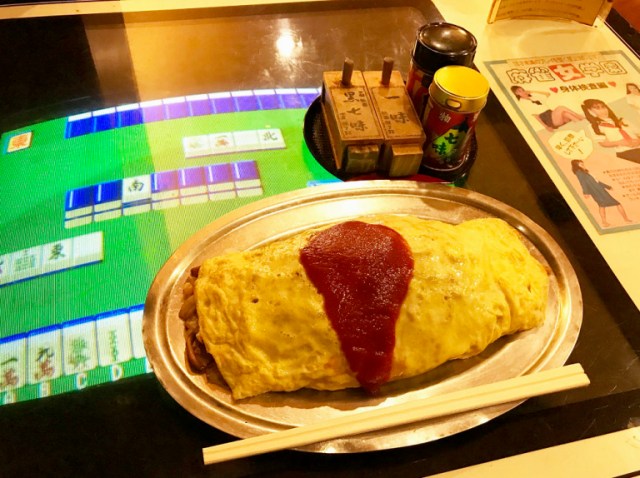
Visit this tucked-away cafe in a popular sightseeing area to experience the atmosphere of a place where time has stood still.
A taste that hasn’t changed in 100 years.
Our Japanese-language reporter Masanuki Sunakoma was intrigued by that boast from Denkiya Hall, a retro-style cafe supposedly packed with Showa-era (1926-1989) relics such as cocktail-cabinet glass tables with built-in arcade games that were all the rage in yesteryear. As a 38-year-old who spent his formative years in the last days of the Showa era, his interest was naturally piqued by what the cafe had to offer, so he went to investigate.
First, a quick note about Denkiya Hall’s unusual naming backstory. The locale was originally established as an electric appliance store, which is known as a denkiya in Japanese (電気屋 in kanji). It was later converted into a cafe known as Milk Hall, and eventually adopted a name that was a blend of the two. The only difference was that this latest iteration of the title was written in phonetic katakana (デンキヤ・ホール) to take away the “electric appliance” nuance.
For a century now, Denkiya Hall has quietly existed within the cluster of storefronts that make up the Senzoku-dori shopping area of Tokyo’s Asakusa district. It’s only about a 10-minute walk from the Asakusa Station complex and located behind the major area tourist-draw of Sensoji (Asakusa Kannon Temple). Compared to the streets around the station that are always bustling with tourists, Denkiya Hall is in a very peaceful area populated mostly by locals and even some other retro-style cafes, and Sunakoma thought that it blended in perfectly with the local surroundings.
▼ Denkiya Hall’s exterior
The interior of the cafe was the very essence of nostalgia. Sunakoma noted the many arcade cabinet tables games scattered throughout the space, as well as that some tables had even been converted to house more modern (yet still retro) titles Wait staff led him to a table featuring a game from 1992: Mahjong: Jogakuen ~Shintaikensahen~ (“Mahjong: Girls’ School ~Physical Examination Edition~”). Even as we leave its dubious-sounding contents to your imagination, we have to admit that the setup was pretty sweet.
There was only one problem he could see: It looked like the screen to his arcade game wasn’t working!
▼ Each table features kuro-shichimi (black seven spices) and ichimi togarashi (chili pepper) specially ordered from the Gion district of Kyoto.
Food offerings included yakisoba, oden, Napolitan pasta, curry, and a variety of other set meals. Sunakoma decided to order the cafe’s special menu item: the Original Founder’s Omumaki (650 yen/US$5.80), an omelet-like dish.
▼ Uh-oh! Did the Heisei era kill the arcade star?
However, it turned out that there was no problem at all. The staff jumped in to say that the game was simply turned off to conserve energy, and that all he had to do was push the power button. The food arrived just as he flipped on the switch, effectively showcasing a Showa-era omelet and Showa-era girls all at once. He was immediately struck by the surreal sensation of the “Showa-ness” of it all.
As the opening sequence of the game played out (some girls running through the school–nothing strange so far…), he sampled a bite of the omumaki. The lightly-fried egg was gently draped over a pile of yakisoba noodles with a thick and heavenly sauce. He couldn’t help being a little distracted by the game, but the food definitely got top marks.
One again, it struck Sunakoma that everything in his line of sight was tinted with Showa-ness: the food, the game, the decor…his head was spinning as if he had slipped back through time. In a daze, he finally remembered that he had ordered a melon cream soda (600 yen) to wash down his meal. It had been ages since he’d last had one of those, but the atmosphere was somehow drawing out his inner child.
While admiring the vivid green of both the game and his soda, he also for the first time realized that the table next to his featured Namco Classic Collection Vol. 2. The familiar noises of Pac-Man and Dig Dug came floating to his ears.
In the end, Sunakoma concludes by saying that Denkiya Hall is the place to go if you want to experience feeling like time has stopped. He’s already planning another visit simply to see how well his Namco skills have held up over the past couple of decades. We certainly hope that we can visit the cafe in the years to come as well, even after the Heisei era ends and most of us are eating at automated restaurants.
Oh, and one more fun fact: There’s a sweet note on the Denkiya Hall’s official website that reads “We welcome foreigners staying in Asakusa. Please come and visit us.”
Cafe information
Denkiya Hall / デンキヤホール
Address: 111-0032 Tokyo-to, Taito-ku, Asakusa 4-20-3
111-0032 東京都台東区浅草4丁目20−3
Open: 9 a.m.-9 p.m. (food available beginning at 11:30 a.m.)
Closed Wednesdays
Website
Photos ©SoraNews24
[ Read in Japanese ]